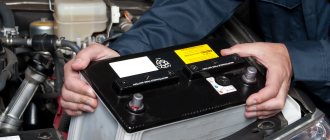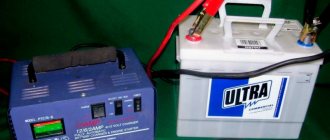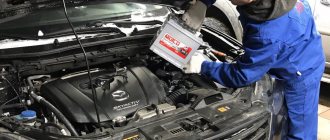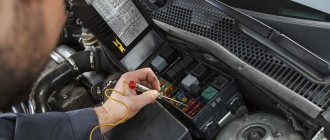The role of the battery in a modern car cannot be overestimated. With its help, the engine starts and it also powers numerous electrical appliances on board. Maintaining the battery in working condition is extremely important, and one of the techniques is to periodically check its capacity. Knowing how to measure amperes on a battery, you can calculate the moment when it will need charging.
Vehicle electrical loads
Electric generator loads can be divided into three separate groups:
- permanent
- long-term
- short-term
The charging system of a modern vehicle must cope with high demands under many different conditions. To get some idea of the power required, add up the power consumed by each individual vehicle component and add that sum to the power required to charge the battery. The table provides a list of typical electrical power requirements for various vehicle systems. For comparison, current consumption is given (to the nearest 0.5 A) at 14 and 28 V (alternator output voltage ratings for 12 V and 24 V systems).
Rice. Alternator Requirements
Some items missing from the list include preheated catalytic converters, electric power steering and heated windshields. This list will expand, and the charging system will have to meet all new needs.
Table. Typical power consumption of vehicle electrical components
| Constant loads | Power, W | Current at 14 V, A | Current at 28 V, A |
| Ignition | 30 | 2 | 1 |
| Fuel injectors | 70 | 5 | 2,5 |
| Fuel pump | 70 | 5 | 2,5 |
| Dashboard | 10 | 1 | 0,5 |
| Total | 180 | 13 | 6,5 |
| Continuous loads | Power, W | Current at 14 V, A | Current at 28 V, A |
| Side and tail lights | 30 | 2 | 1 |
| Room lighting lights | 10 | 1 | 0,5 |
| Driving lights | 200 | 15 | 7 |
| Low beam headlights | 160 | 12 | 6 |
| Instrument lights | 25 | 2 | 1 |
| Receiver/Tape/CD | 15/30 | 1,0/2,0 | 0,5/1,0 |
| Total (at average headlight load) | 260-270 | 20 | 10 |
| Short-term loads | Power, W | Current at 14 V, A | Current at 28 V, A |
| Heater | 50 | 3,5 | 2 |
| Indicators | 50 | 3,5 | 2 |
| Brake lights | 40 | 3 | 1,5 |
| Front wipers | 80 | 6 | 3 |
| Rear wipers | 50 | 3,5 | 2 |
| Power windows | 150 | 11 | 5,5 |
| Radiator cooling fan | 150 | 11 | 5,5 |
| Interior heating fan | 80 | 6 | 3 |
| Rear window defroster | 120 | 9 | 4,5 |
| Indoor lamps | 10 | 1 | 0,5 |
| Sound signals | 40 | 3 | 1,5 |
| Rear fog lights | 40 | 3 | 1,5 |
| Reversing lights | 40 | 3 | 1,5 |
| Additional lamps | 110 | 8 | 4 |
| Cigarette lighter | 100 | 7 | 3,5 |
| Headlight cleaner | 100 | 7 | 3,5 |
| Seat adjustment | 150 | 11 | 5,5 |
| Heated seat | 200 | 14 | 7 |
| Sunroof drive motor | 150 | 11 | 5,5 |
| Electric mirror drives | 10 | 1 | 0,5 |
| Total | 1.7 kW | 125,5 | 63,5 |
Short-term loads occur infrequently, and some energy consumers, such as heated rear windows and seat heaters, are usually equipped with a timer relay. Therefore, to simplify further calculations, a coefficient of 0.1 is applied to the total amount of required power. The vehicle is expected to use this amount of power under normal driving conditions.
The consumer requirement for an alternating current generator is the sum of constant loads, long-term loads and short-term loads (with an applied coefficient). In this example:
180 + 260 + 170 = 610 W (43 A at 14 V).
Consequently, the demands placed on the charging system are quite significant. This load is in addition to the current required to recharge the battery.
Source of the article: https://ustroistvo-avtomobilya.ru/akkumulyator-generator-starter/elektricheskie-nagruzki-avtomobilya/
In winter time
In winter, many drivers notice that as the temperature drops, it becomes more difficult to start the engine. The battery stops working at full capacity. Some car enthusiasts remove the battery at night and leave it warm. In fact, when fully charged, the voltage does not drop, but even increases.
Negative temperature affects the density of the electrolyte and its physical state. When fully charged, the battery can easily withstand frost, but as the density decreases, there is more water and the electrolyte may freeze. Electrochemical processes occur more slowly.
At -10°C -15°C, a charged battery may show a charge of 12.9V. This is fine.
At -30°C, the battery capacity is reduced by half of its nominal value. The voltage drops to 12.4V at a density of 1.28 g/cm3. Also, the battery stops charging from the generator at -25°C.
As you can see, negative temperatures can significantly affect the performance of the battery.
With proper care, a liquid battery can last 5-7 years. During the warm season, you should check the charge level and electrolyte density at least once every two to three months. In winter, at an average temperature of -10°C, you need to check the charge at least once every two to three weeks. In severe frosts -25°C-35°C, it is advisable to recharge the battery once every five days, even during regular trips.
How many amperes are in the cigarette lighter of a car and truck?
To connect additional equipment in the car, use a socket or cigarette lighter socket. The circuit is equipped with a fuse to provide protection against short circuits. The owner needs to know how many amps there are in the car's cigarette lighter, since connecting devices with excessive power may damage the electrical wiring.
Cigarette lighter amperage
A car cigarette lighter is a metal cup with contact plates into which a plug with an incandescent coil is inserted. The permissible current in the circuit is calculated depending on the resistance of the filament element and the voltage in the on-board network (according to Ohm's law). The cross-section of multi-core switching wires and the rating of the fuse, which is installed in the cabin unit (installed in the instrument panel or in the luggage compartment of the car), are selected accordingly.
Please note that the equipment is designed to operate at maximum power for 10-15 seconds. After heating the spiral, the bimetallic lock is activated, and the spring built into the plug automatically opens the contacts. The fuse rating is in the range from 10 to 15 A (depending on the manufacturer and model of the machine, information is indicated in the operating instructions).
In the event of a short circuit, the fuse jumper cannot withstand the increased current and is destroyed, breaking the circuit.
The machine owner must replace the insert with an element with identical operating parameters. The use of high-rated fuses or homemade devices (“bugs”) is strictly prohibited. If the insert fails again, it is necessary to diagnose the electrical circuit and eliminate the cause of the short circuit.
What kind of charging should go to the battery from the generator?
It is traditionally believed that 13.5-14.5V should be supplied by the generator to the battery and this is absolutely enough to replenish the battery costs.
It is worth considering that using a battery with a higher power in a car than the manufacturer recommends also requires the installation of a more productive generating device.
It is necessary to take into account the load that the generator must withstand - it is calculated based on the maximum indicators of all electrical appliances and car systems.
Do not forget that the charging current from the energy-generating device will allow you to start the car in the cold season. In order to avoid problems with starting the car, we recommend purchasing generating equipment, the charge current of which will be approximately 10% of the capacity of the power source. That is, a battery of 100 A/h requires a generator that can produce 10A. Please note that for many cars, 100 amp equipment will operate at its maximum capacity, because the power consumption of the automotive system is in the region of 80 amps. Therefore, the choice of a source generating energy must take into account both the battery capacity and network consumption.
Cigarette lighter voltage
The nominal voltage from the cigarette lighter circuit on passenger cars is 12 Volts. After starting the power unit, the parameter increases to 13.8-14.1 Volts (determined by the settings of the relay regulator on the generator, the engine speed and the power of the electrical appliances turned on). On trucks (for example, KamAZ or MAZ), the voltage in the on-board network is increased to 24 V, and accordingly, the operating rating of the heating element is increased.
Additional factors affecting the voltage in the cigarette lighter power circuit:
- temperature of the generator windings (when cooling, the voltage increases by 0.3-0.5 V);
- condition of the brushes.
When the cigarette lighter is in operation, the voltage in the on-board network may decrease due to increased load (for example, due to a short circuit or connection of devices with increased energy consumption). When the car is moving, the problem is not noticed by the driver, since the voltage drop is compensated by the operation of the generator. The defect can be detected when the engine is idling or when the power unit is turned off. It is recommended to reduce the load power and eliminate sections of electrical wiring with damaged insulation.
If, when measuring, the voltage in the cigarette lighter is lower than the nominal value or less than the parameter measured at the battery terminals, then you need to check the condition of the device. When oxides form on metal contacts or dirt settles, current conductivity deteriorates, which negatively affects the operation of electrical devices. Problems also arise when electrical wiring rots (for example, due to condensation that gets into the connecting plugs).
Step-by-step procedure for checking the generator
- Turn on the ignition and make sure that all the dashboard lights are on.
- We start the car, and if the generator is operating normally, the battery warning light should go out.
- We wait until the car warms up to its standard operating temperature of 90 °C.
- When it warms up, it is necessary to load the network as much as possible. To do this, we turn on everything that is in the car, including heated mirrors, lights, music, etc.
- We take a pre-prepared multimeter and set it to the “voltage” check mode.
- Next, we call an assistant and ask him to keep the engine speed at idle (within 3500 - approx.).
- Using a multimeter, we connect its probes to the battery, and at the moment when all consumers are turned on, the readings should not fall below - 13-13.2 V.
Cigarette lighter power
To calculate the maximum power, use a formula of the form P=I*U*a, where:
- P - design power;
- I is the current strength in the power circuit;
- U - operating voltage
- a is a correction factor that takes into account losses in the power supply circuit (not taken into account in basic calculations).
For example, if the device is designed for a voltage of 12 V and a current of 15 A, then the maximum power consumption is 12 * 15 = 180 W. This parameter determines the short-term load on electrical circuits; it is prohibited to switch equipment with similar energy consumption for a long time. When electric current flows, the metal strands of the wiring heat up, which causes the insulation to melt or burn. To switch devices, you should use a standard socket or a socket installed yourself.
How to replace and where is the fuse for the cigarette lighter of Ford Focus 2. Detailed instructions for removing and replacing the cigarette lighter fuse at home.
Is it possible to increase or decrease the indicators?
Car manufacturers strictly prohibit interfering with the design of standard electrical wiring. Installing fuses with a higher rating leads to overheating of electrical harnesses and destruction of insulators. In the event of a short circuit, the insert is not destroyed, which leads to heating of the metal cables and a fire in the instrument panel or engine compartment. Since the design of the car uses flammable materials, the slightest fire in the cabin leads to complete burnout of the car.
During operation of the machine, you should not install splitters for several devices in the standard cigarette lighter, which do not ensure the safety of the electrical circuit connection. If there is poor contact between the insert and the body, the metal contacts burn, impairing the conductivity of the metals. In this case, it is necessary to replace worn parts; traces of carbon deposits are removed with sandpaper.
If the owner of the car wants to connect equipment with increased power (for example, an electric pump for inflating tires), then it is necessary to install a separate outlet. The device is connected directly to the battery; a protective fuse is provided in the circuit. For connection, copper wire with an increased cross-section is used, capable of withstanding increased load. Switching through a relay is allowed, allowing the socket to be used only after the ignition is turned on (to protect the battery from discharge).
How to determine how many ampere hours are in a car battery and how many amperes are needed for charging
Many car enthusiasts, while operating their cars, ask the question “how many Amperes are in a 12 volt car battery?” The question is not entirely correct, since current is measured in Amperes, and a battery at rest does not generate current, so this value will be zero. It would be more correct to ask the following question: “how much current can the battery produce at the nominal peak of consumption?”, since the indicator may vary depending on the model and design of the battery.
In a car battery, the voltage at the terminals is from 10.5 to 12.7 volts. In this case, the current strength can rise from 0 to 150 Amperes - depending on the intensity of energy consumption. The starter produces an average power of 1.5 to 2 kilowatts, respectively, at a voltage of 12 volts, the car battery should show a current of at least 125 Amps.
What causes deviations from the norm of 12.6-12.7 V
Deep sulfation of the plates prevents the restoration of voltage without load to normal values. In general, this is not its only sign:
- The density of the electrolytic liquid in the jars decreases.
- The battery discharges quickly and charges quickly.
- The plates are covered with a white layer.
Large sulfates do not dissolve during a normal charging cycle at 10% of the battery capacity. Therefore, the charging time from a standard charger is reduced, and the electrolyte boils quickly.
The progression of sulfation is caused by storage in a discharged state. A special case is use in chronic undercharging mode. Neither calcium nor progressive AGM and EFB batteries are capable of resisting destruction.
What is current strength?
So, to understand the issue of current strength in a battery, let's remember 8th grade physics. We all remember that electric current is the directed movement of charged particles along a conductor.
This is the concept of current strength: the higher it is, the more electricity passes through the cross section in a fixed period of time. To simplify the concept, I will give a definition from the textbook: “Current strength is the amount of electricity passing through the cross-section of a conductor in one second.” The current strength throughout the entire circuit is the same, but this rule only applies under ideal conditions on the pages of a school textbook. In reality, the parameter may vary somewhat depending on temperature, circuit complexity, and the presence of extraneous sources of electromagnetic radiation.
Battery types
There are 2 types of batteries: acid, which use sulfuric acid as an electrolyte, and alkaline (the electrolyte is an alkaline solution). Alkaline ones react sensitively to low temperatures, so they are rarely used in cars.
- Antimony – the plates contain a lot of antimony (>5%). Outdated technology, such batteries are no longer produced. They have a long service life and can withstand a large number of charges and discharges;
- Low antimony - an analogue of the previous one only with a reduced antimony content and higher quality technical characteristics;
- Calcium - contain calcium instead of antimony, sometimes with a small admixture of silver. They have more stable characteristics, but are very sensitive to deep discharge;
- AGM or Gel batteries - a new technology, the electrolyte is in a bound state in the form of a gel. They have a high cost (for comparison, if a good calcium battery can be purchased for 3-5 thousand rubles, then for a similar gel battery the price starts from 10 thousand.) They have high quality characteristics, but require special charging equipment, since they are charged at lower current values.
- Nickel - contain nickel associated with cadmium (Ni─Cd) or metal hydroxide (Ni-Mh) have good quality characteristics, but are not used in cars due to their large dimensions (the specific current of alkaline batteries is less than that of acid batteries, therefore more cells are needed). They are used in electric forklifts and are sometimes installed on trucks.
- Lithium (Lithium-ion) - cheap to produce, but sensitive to low temperatures. The main consumption segment is electronics. Starter batteries for cars with internal combustion engines are not produced using this technology. Often used in electric vehicles.
How should you charge a car battery?
There are two ways to charge the battery. The first of them is relevant if the battery is working and the car can start. To charge you do not need to remove the battery, just drive the engine at high speeds for 10-15 minutes. The main thing is to follow two rules:
- Do not do this in a closed space (for example, a garage or repair bay), otherwise you will suffocate from exhaust gases;
- Do not turn on lighting fixtures.
After all these steps, the battery will gain sufficient charge and will gradually recover if you operate the car for at least several hours in a row. It is advisable to do this during the daytime so as not to create an increased load on the battery with the headlights and interior lighting on.
For the second method, you will need a charger. You need to proceed in the following order:
- Remove the battery from the engine compartment and place it on a flat surface.
- Unscrew the battery caps to allow gas to flow out during charging.
- Cover the holes (loosely) to prevent acid from splashing onto the top of the battery. To do this, you can simply turn the plugs over with the threads facing up and place them in the grooves of the holes.
- Connect the charger to the battery - plus to plus, minus to minus.
- Connect the battery to the network and set the input current equal to 1/10 of the battery capacity (for example, with a volume of 55 A/h, you need to set the indicator to 5.5 Amperes).
- Leave the battery alone until active gas formation begins in all cells. On average, a full charge takes 8-10 hours, but this figure is relative and varies depending on the degree of battery wear, temperature, and other things.
- After disconnecting, do not immediately tighten the plugs; wait at least 20 minutes for the remaining gas to evaporate from the battery capacity.
- Then tighten the plugs and install the battery in the car.
To understand how many amperes there should be when charging a battery, you need to know exactly the battery capacity. Otherwise, charging may be too slow (if you set the value below the required value), or, on the contrary, the batteries will be overcharged, which will negatively affect its resource.
It is also worth being able to determine the state of charge of the battery. This can be done using a multimeter. A car battery provides 100% charge at the terminals of 12.6-12.7 Volts. If the indicator decreases to 12.5, then this means that the charge has dropped by 10-15%. In a regularly driven car, the current power generated by the battery is on average 12.2-12.3 Volts, and this is normal, since the battery in a car is never 100% charged except for those moments when it is removed for recharging or replacement.
What is the current in the car network, direct or alternating?
If the readings are lower at such engine speeds, this will indicate that the generator is not producing the required amount of energy. And when they are normal, we continue testing with switched off consumers at the same speed. In this case, the multimeter readings should be about 14.5-14.7 V.
Checking the voltage supplied by the generator
After diagnosing the battery, we go directly to the generator using the same multimeter.
- When the car is started, we connect the probes to its terminals, and the voltage should be at least 14-14.3 Volts.
- Next, as the speed increases, we monitor the instrument readings, where the values should not change by more than 0.5 volts. If this is not observed, this will mean that the generator and voltage regulator are functioning correctly.
There is an excess of overvoltage in the network.
Now, having reliable information about how many volts the generator should produce, you will know for sure whether it is working or not. And if the readings differ slightly from the norm, then first of all you should pay attention to the malfunctions described below.
Summarizing
Car enthusiasts should know that the battery discharges on its own. This happens if the car is not used for a long time. If you have a new battery installed and you have parked the car, then after 12 months it is not a fact that you will be able to start it. In old batteries this figure is even less - no more than a month.
Therefore, when storing a car for a long time, it is worth visiting it periodically and warming it up - at least once a month. This will not only preserve the battery, but also prevent the oil from emptying in the engine crankcase. After a deep discharge, charging the battery becomes difficult, and in some cases impossible, so if you decide to start the car after a long period of parking, then buy a fresh battery.
Source of the article: https://3batareiki.ru/akkumulyatory/avtomobilnye-akkumulyatory/kak-opredelit-skolko-amper-chasov-v-akb-avtomobilya-i-skolko-amper-nuzhno-dlya-zaryadki
How to use the leakage current calculator
In order to calculate what the permissible leakage should be, you need to:
- Check the boxes to indicate which standard consumers you have. Please note that tuning of multimedia and audio systems, as well as autonomous engine control systems, is not taken into account, since there is no single value for current consumption.
- Indicate the capacity of the installed battery.
- Select the relative age of the battery (self-discharge will depend on it, since in addition to provoked and operational discharge there is also electrolytic and natural).
- By clicking the “ Calculate ” button, in the “Permissible leakage current” field you will receive the result of the permissible quiescent current.
After turning off the ignition, current consumption should either stop completely or be minimal, and its value can not be taken into account at all. Modern business class cars can easily sit from autumn to spring, and will start with half a turn. The same cannot be said about other budget foreign cars. On the contrary, they suffer from excessive quiescent current. It is capable of draining the battery not just in a month, but literally in a week (sometimes even in a day).











